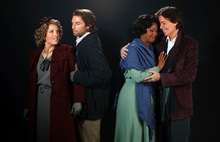This is an archived article that was published on sltrib.com in 2010, and information in the article may be outdated. It is provided only for personal research purposes and may not be reprinted.
"La Bohème" is, if not the world's most popular opera, at least in the top three. If this fact mystifies you, Utah Opera's season-opening production may not convert you. But if you are one of the opera's many devotees, you'll revel in the beautiful singing and fabulous look of this updated staging, as the opening-night crowd did.
Soprano Laquita Mitchell and tenor Gerard Powers starred as Mimì and Rodolfo, the impoverished young couple at the center of this slice-of-life opera. They won over the crowd with their fresh-sounding singing and sensitive acting. The secondary leads, baritone Brian Leerhuber and soprano Celena Shafer as Marcello and Musetta, registered even more strongly (maybe a bit too strongly in the case of Shafer's over-the-top antics in the Café Momus scene).
Bass Derrick Parker played the philosopher Colline, whose farewell to his overcoat in the last act was as moving as any of the farewells in this show. Baritone Brent Reilly Turner, as the musician Schaunard, rounded out the quartet of bohemians. The four men conveyed a lively sense of camaraderie, especially in the carefree clowning in the last act. Bass Ryan Allen provided solid singing and comic relief in the dual roles of landlord Benoit and sugar daddy Alcindoro.
There were some nice, telling moments in Saturday's performance, stage directed by Crystal Manich. Leerhuber had a poignant turn at the end of the third act, in which Marcello plays wistfully with one of the gloves Musetta left behind, that spoke volumes. Powers echoed that moment in the next act as he contemplated Mimì's forgotten bonnet — a sweet bit of symmetry.
The Utah Opera Chorus, augmented by 20 young singers from the Madeleine Choir School, contributed its usual fine work thanks to chorus master Susanne Sheston's expert preparation.
Susan Memmott Allred's costume designs ensured that the singers looked as good as they sounded. The costumes were integral to the visual success of this production, which moves the action of the opera from the 1830s to 1939.
The handsome sets, designed by Michael Yeargan, received some deft updating — for example, the colorful poster outside the café advertising Josephine Baker's appearances at the Folies Bergère. Rodolfo's typewriter was another nice touch.
Leonardo Vordoni led the Utah Symphony in a colorful performance of Puccini's score. With a plot thinner than poor Mimì's shawl, "La Bohème" succeeds on the strength of its music. This opera boasts not only some of Puccini's most heart-tugging melodies, but also some of his most brilliant orchestration. The opening pages of Act III are some of the most vivid in the operatic canon, ranking right up there with the Nile scene in "Aïda."
Harpist Louise Vickerman and the woodwind players (led by flutist Lisa Byrne) made the most of this lovely, snowy scene. Concertmaster Ralph Matson also had some beautiful solo moments.
Catherine Reese Newton is a music critic. Contact her at creese@sltrib.com or 801-257-8616. —
La vie bohème
P Rodolfo, Mimì and their friends step seamlessly into 1939 Paris in this well-sung, handsomely staged production.
Language • The opera is sung in Italian, with subtitles in English.
Where • Capitol Theatre, 50 W. 200 South, Salt Lake City.
When • Reviewed Saturday, Oct. 16; performances continue Oct. 18, 20 and 22 at 7:30 p.m., with a 2 p.m. matinee Sunday, Oct. 24.
Running time • About 2½ hours, including two intermissions.
Tickets • $15-$85 at 801-355-ARTS, the box office or http://www.utahopera.org. Prices rise $5 on performance day.
Learn more • Utah Opera artistic director Christopher McBeth will conduct a Q&A in the theater's mezzanine-level Founder Room after each performance.



